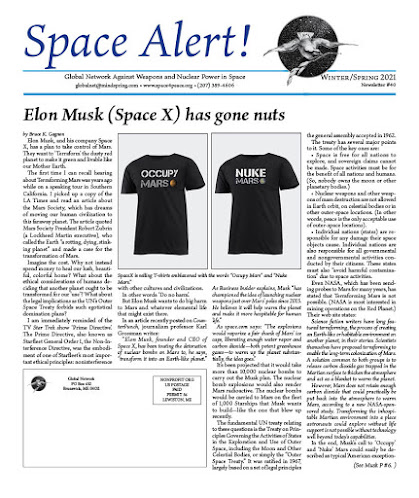Preview: Latest Space Alert newsletter
Our current Space Alert newsletter is now at the print shop and is also available online here
Below are a few bits from the latest edition which has a focus on impacts from the growing numbers of spaceports around the world and their launches. Increasingly crowded orbits result as well as continued destruction to the ozone layer from toxic rocket fuels.
- During this past year we’ve been witnessing a virtual explosion of plans to construct new ‘spaceports’ at various locations around the world. Proposals have included building them in Scotland, Hawaii, Maine, Japan and beyond. Some are still in the works and others have been put on the shelf for now. Space X and other corporate-owned launch companies are scanning the globe for launch sites as the ‘need’ for tens of thousands of mini-satellites for 5G are making the aerospace industry drool as they envision the money that can be made hoisting them into the heavens.
- A couple big problems immediately come to mind when I think of thousands of mini-satellite launches. One would be the toxic rocket exhaust punching a hole in the Earth’s ozone layer thus making our climate crisis worse. The growing space debris problem, with increasingly congested orbits adding to the mess, makes the chances of an accidental avalanche of crashes in space more likely. This could ultimately make it impossible to launch a rocket off Earth due to the ‘minefield’ of space junk circling our already fragile planet. Astronomers are upset about the dark night sky being fouled by legions of new blinking satellites encircling our planet.
- Today Sweden has joined the club [NATO]. Numerous bases are installed from the North to the South in the “neutral and non-aligned” country of Sweden. We have Lerkil in the South and Esrange in the North of Sweden—the world ́s biggest downloading station from satellites. Sweden has, with its vicinity to Russia, become a servile obedient vassal state to the U.S.
- Rocket Lab (RL) was founded in 2006. Its founder and CEO is Peter Beck, a high-profile New Zealand (NZ) entrepreneur who was a finalist for New Zealander of the Year 2020. He personally and Rocket Lab, the company, have enjoyed consistently favourable treatment from both the NZ media and successive governments. RL was originally touted as a shining example of Kiwi innovation and continues to be under the Jacinda Ardern government. But, in fact, it is now simply the NZ subsidiary of an American company, with major ownership by Lockheed Martin, the world’s biggest weapons manufacturer.
- Space is now big business and seen by the (UK) government as one potential path to recovery from the economic havoc caused by Covid-19. Forecasts suggest it could be worth over $1 trillion by 2040 and the UK aims to capture 10% of the market by 2030. A consortium of Local Enterprise Partnerships (LEPs) which bring together local authorities, academic institutions, research groups and businesses are establishing several regional space hubs around the UK to ensure that space is a priority for regional economic growth. Among them is ‘AstroAgency’ which operates across Scotland on behalf of the Scottish Space Leadership Council. Lockheed Martin has chosen Unst—one of the Shetland Islands—to develop its own Shetland Space Centre (SSC) for vertical launch operations. So, the UK is now well on the way to being directly involved in US plans for space domination.
- SpaceX may be the dominant player, but it is far from the only U.S. company with plans to slather “every inch of the world” with emissions from low-orbit 5G satellites. Amazon, angling for a potential four billion new customers, plans to launch a total of 3,236 satellites and promises to start delivering Internet services. Facebook is also planning for thousands of satellites.
- The Space Development Agency (now integrated with the Space Force) selected Elon Musk’s company SpaceX as the launch provider for its first 28 satellites, awarding the company a $150 million contract for two launches. SpaceX is expected to conduct the first launch in September 2022. All satellites need to be on orbit by March 31, 2023. The satellites will form the layers of the SDA’s National Defense Space Architecture, a constellation in low Earth orbit that will be able to ‘push targeting data to war fighters, track hypersonic weapons, connect sensors and shooters over the orbit network’. While the NDSA will eventually include hundreds of satellites, the agency isn’t putting them all up at once—the agency plans to add a growing number of satellites every two years.
- In 1978, NASA scientist Donald Kessler warned of a potential catastrophic, cascading chain reaction in outer space. Known as “Kessler Syndrome,” the theory posited that orbits above Earth could one day become so crowded, so polluted with both active satellites and the junk from of past space missions, that it could render future space travel problematic and even impossible.
- The plunge into Earth’s atmosphere of worn-out satellites, rocket parts and other space junk is a common occurrence. For spacecraft re-entries, that process means basically ‘burning computers'. During re-entry, big chunks of aluminum and other materials are subjected to intense heating. Some particles are very reactive, so even small amounts of them could have a significant effect on atmospheric chemistry.
- The Tromsø municipal council in northern Norway has decided to say NO to a port for U.S. nuclear-powered submarines. This prompted the Norwegian Minister of Defense to react: “Tromsø cannot opt out of NATO”, he said in October. The federal government is pushing hard to override local politicians and public opinion. Tromsø is the third largest urban municipality in Norway, and the seventh in population. Tromsø is the regional civil administration center for the northern area in Norway. Tromso is very close to the Russian border along the Barents Sea.



0 Comments:
Post a Comment
Subscribe to Post Comments [Atom]
<< Home